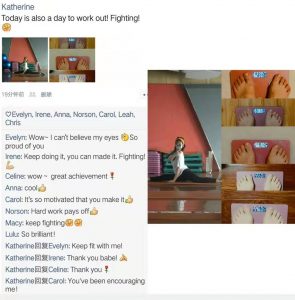CMP-Summative Assessment 2018-2019 (photography)
PHOTOGRAPHY
The motivation, authenticity and character setting of selfies on social media
Example 1

Figure 1- Screenshot from Sister Dudu’s Tiktok Account
(https://v.douyin.com/CV7o61/)
This example comes from Sister Dudu, a video player active on social media platform douyin, has become popular by regularly uploading selfie videos of herself. She is best known for the covers of her videos. Different from other video players, Dudu’s video cover shows her with small eyes and big buck teeth, which makes her very ugly when she smiles. At first, netizens(net citizen) left messages on her video poking fun at her looks and even attacking her. Dudu sister did not think so, still upload a selfie video and use the same kind of video cover. In the video cover, he keeps smiling, is optimistic and often makes people laugh. Gradually, people were moved and infected by the girl who was not beautiful but very optimistic, and more and more people began to pay attention to and support her. Internet users will also feel that looks are not important, positive attitude is the most important. They have said that they see the appearance of dudu sister also become positive up. But over time, a netizen reported the true face of sister Dudu is not so ugly in real life, her appearance is very ordinary, and that netizen post the real picture of Sister Dudu, the picture of sister Dudu is just a normal girl, completely not as ugly as she in her video and cover . After that, Sister Dudu also had to admit that their upload video is processed with filters and photoshops. When the truth comes out, netizens were disappointed that the ugly and optimistic girl was just an ordinary person. Dudu sister also apologize that he was just originally dressed up as ugly for make some fun on internet, did not expect netizens to believe it. However, people believe and she thought it might make her famous, so she deceived everyone. Thus, The significance of selfies and authenticity on the Internet is worth considering.
(Word count: 318)
Example 2

Figure 2- Screenshot from Victioria’s Instagram Account
(https://instagram.com/victoriagarrick?igshid=1uf6ov186tqt6)
This example comes from Victoria Garrick’s Instagram website. Victoria is a mental health and body-image advocate, she was also a volleyball player for her college team. She often shares her life on the Instagram platform. She would post photos of herself, share photos of her sports, her events, and sometimes she would give TED talks, and people thought she was the perfect person. She freely admits that sometimes her selfies are edited and she sends out the original for comparison. It is obvious from many comparison pictures that she will slim down and filter the photos before sending them. She also posts photos of herself with makeup and without makeup photos, confessing that she thinks her makeup looks beautiful but less authentic and comfortable. A set of photos of her at the end of her workout got a lot of thumb up on Instagram. The photo on the left shows her deliberately sucking on her belly to show off her flat belly, while the photo on the right shows her completely relaxed with many folds on her belly. ‘I need to suck my tummy while taking the photo on the left,’ she wrote below. ‘it’s not a post-workout break, it’s not relaxation, it’s just for the sake of looking good.’ And the picture on the right, although the wrinkles on the belly are exposed, is really relaxing and resting, which is the real rest. Victoria has built a healthy, confident and authentic self on Instagram, calling for people to live healthy lives and face up to their true selves. Netizens said they liked her honest expression and praised her for facing up to her true self.
(Word count: 278)
Creative Response

Figure 3- Screenshot from my Wechat moment

Figure 4- Screenshot from my Instagram
(https://instagram.com/ouchzyl___?igshid=1v1re11a1pxdn)
Commentary
Selfie in the Oxford dictionary is classified as ‘A photograph that one has taken of oneself, esp. one taken with a smartphone or webcam and shared via social media.’(Oxford Dictionaries | English, 2018). The word “selfie” was also named one of the world’s hottest words (Al-Kandari and Abdelaziz, 2018, p.1849). Nowadays, selfies are very common. People can take selfies on the road, and tourists can take selfies with buildings at tourist sites. On social media, more and more people are Posting selfies on the platform. Many times the reason for taking selfies comes from people’s narcissism, confidence and self-esteem(Al-Kandari and Abdelaziz, 2018, p.1853). But the real motivation for taking selfies is complicated,most of the real motivation for selfies comes from people seeking self-evaluation, entertainment, status updates and a record of their lives(Al-Kandari and Abdelaziz, 2018, p.1849).
Posting selfies can satisfy the vanity of rising fans and get better reviews. Study(Pounders, Kowalczyk, and Stowers, 2016) showed that people are adept at disguising themselves with fake selfies to hide their lack of confidence, as long as they receive a satisfying return (complimentary comments and thumb up, rising followers and click-through rates). In the first example, sister dudu with a fake selfie cover in the Internet hit, netizens think that the picture of the ugly but optimistic girl is Sister Dudu herself. As more and more fans pay attention to her and follow her because her role. Sister Dudu did not clarify she is not as ugly as the selfie cover and selfie video which she uploaded, but continue to upload videos to let everyone believe it. This is a form of deception for consumers. She build a fake character of optimistic and positive on the platform of Tiktok. Although this that personality is positive, it is fake after all.
There is nothing wrong with sharing the normal life status on social networks through selfies, so that people can pay attention and communicate with each other. However, there are also some people who show off the better side of their life, even a small part of the luxurious life scenes, and appear in high frequency, which inevitably makes the audience feel strange. A study(Chen, S. et al.,2019) by researchers on identity building on Facebook found that people present themselves on Facebook as they expect to be rather than as they really are. When we show ourselves on social networks, we highlight or even exaggerate the parts that we want to show more, such as exquisite faces, extraordinary experiences, outstanding abilities, etc. They also deliberately hide or weaken the selves they are unwilling to show in social networks, such as those who are fat, sloppy, boring, or frustrated.
Either people look in the mirror or take photos, the process of self-knowledge itself is a process of self-reinforcement (Ibrahim, Y, no date, p.320). There is a kind of self-satisfaction and reinforcement in the viewing process. The instinct of peeping everyone has made these selfie photos have a great market on the Internet, which in turn greatly stimulated the excitement of these selfies, giving them a sense of satisfaction, and then, in order to get more attention, Self-portraitrs will compare with others, and this kind of stimulation will make them more enthusiastic about it.
Selfies give people the right to express themselves (Kedzior, and Allen, 2016). In Victoria’s case, she was always daring to face her true self. Uploading images on social media is a way to bridge the gap between the audience and the selfie-taker. In Victoria’s case, she was always daring to face her true self. Between the perfect selfie and the real one, her selfies speak for women’s body-image equality, calling for people to face up to who they really are, and not to hate their own shortcomings because of what others think. They are also beautiful. The potential for empowering selfies is inherent in the visual structure of selfies(Zhao and Zappavigna, 2018). From the birth of selfies to uploading to social media platforms, there are often three steps: shooting, editing and sharing(Chen, et al.,2019). How to find the Angle when shooting, how to beautify when editing, and which picture should be chosen when sharing to the platform all need thinking. This process is shown in the comparison picture of Victoria when she finished running. During the first picture of perfect rest, she posed at an Angle to make sure her stomach looked smooth and firm. She added filters to the photos after they were taken. In sharing, she chose the best one.
In my creative respond, I Shared two sets of photos from my WeChat moments and Instagram, both of which were fake to varying degrees, but both received good responses. First of all, the first set of photos came from my WeChat circle of friends. I posted two pictures. The first one was a selfie of me doing splits at the gym, and the second one was several photos of my weight changing from high to low. “Today is also a day to work out! Fighting!” . Obviously, what I mean by this circle of friends is that I’ve lost weight through fitness and I’m still working out. In this circle of friends, my friends praised me and gave me support and encouragement. I was very happy to receive such feedback, and I easily established my healthy and hardworking personality in my WeChat circle of friends. But what is not known is that the photos are not authentic. I didn’t lose weight through exercise. I lost weight through diet and diet pills. During my weight loss, I didn’t do any exercise. Although the first photo was actually a selfie of me doing the splits, I learned to dance as a child, so the splits were easy for me to do and just take a picture, which probably took me less than 10 seconds.
The second set of photos shows I was going to make sushi so I put my hair up for convinient. And the second picture shows the sushi done, with the caption that it’s healthy to make it myself. After I posted the photos, I also received a few likes and a lot of complimentary comments. I didn’t make the sushi, I bought it from the supermarket that day. When I put my hair up for a selfie, it was only because I wore delicate make-up and looked better with my hair up. I have to admit, I used the beauty feature for this selfie. My eyes were enlarged and the freckles were gone. Once again, I present a positive side to social media that doesn’t belong to me. The reason I really hope is ture to lose weight is that I’ve been working on for a long time, and also I really hope is ture is that I can make sushi myself. However, I don’t have the stamina to keep fit, and I don’t know about how to make sushi. I really hope I can really be the one in the photo I have post. The motivative of I post these photos is not only in order to gain from the praise and envy of others, but also shows that I’m not confident in real life. That’s why I post these fake selfies to feed my vanity. At the same time, the lack of authenticity of these photos constitute an unstable style, with the real me formed a sense of self (HESS, 2015, p.1635).
Selfies are an idealized pursuit of the self, and by Posting selfies one can gain solace, and by Posting selfies one can build a virtual human being. The two examples mentioned above and my creative response also led to the reflection on the authenticity of selfies on social networking sites. The best way to take a selfie is to record life, to memorize the changes of time and space (HESS, 2015). People want to peep, but the body is tame, they see the “beauty” of the body is so similar; People want to convey their identity and show themselves, but excessive beautification makes them not show their real “selves”; People want to interact socially through online selfies, but only hear their own echoes. While attracting attention, people are also revealing their privacy.
However, the problem for many people is that they take tools as the purpose, and replace experience with records. They put the cart before the horse, so that wherever they go, they always take photos for the first time, instead of using their five senses to feel and experience. It seems that the function brought to them by a place is just taking photos. Yes, in some cases, it is necessary to take photos as a souvenir, but if an experience or a scenic spot, you do not carefully feel the washing and inspiration it brings to you, just simply take photos, except to make you narcissistic and show off, what’s the point? Feel first, experience first, observe first, smell first — let the brain record first, and then use the camera as a tool to record better. Whatever do, make sure the place doesn’t leave you with just a few optional photos.
(Word count: 1526)
Reference List
Al-Kandari, A. A. and Abdelaziz, Y. A. (2018) ‘Selfie-taking motives and social psychological dispositions as predictors of selfie-related activities among university students in Kuwait’, Mobile Media & Communication, 6(3), pp. 291–308. doi: 10.1177/2050157917737124.
Chen, S. et al. (2019) ‘Daredevils on social media: A comprehensive approach toward risky selfie behavior among adolescents’, New Media & Society, 21(11–12), pp. 2443–2462. doi: 10.1177/1461444819850112.
Dudu, S. (2019). [Tiktok] Available at: https://v.douyin.com/CV7o61/ [Accessed 23 Nov. 2019].
Garrick,V.(2019). [Instagram] Available at: https://instagram.com/victoriagarrick?igshid=1uf6ov186tqt6 [Accessed 23 Nov. 2019].
HESS, A. (2015). The Selfie Assemblage. International Journal of Communication, 9, pp.1629–1646.
Ibrahim, Y. (no date) ‘Coalescing the mirror and the screen: consuming the “self’’ online”’, CONTINUUM-JOURNAL OF MEDIA & CULTURAL STUDIES, 31(1), pp. 104–113. doi: 10.1080/10304312.2016.1239066.
Kedzior, R. and Allen, D. (2016), “From liberation to control: understanding the selfie experience”, European Journal of Marketing, Vol. 50 No. 9/10, pp. 1893-1902.
Oxford Dictionaries | English. (2019). selfie | Definition of selfie in English by Oxford Dictionaries. [online] Available at: https://en.oxforddictionaries.com/definition/selfie [Accessed 23 Nov. 2019]
Pounders, K., Kowalczyk, C. and Stowers, K. (2016), “Insight into the motivation of selfie postings: impression management and self-esteem”, European Journal of Marketing, Vol. 50 No. 9/10, pp. 1879-1892. https://doi.org/10.1108/EJM-07-2015-0502
Zhang,Y(2019). [Instagram] Available at: https://instagram.com/ouchzyl___?igshid=1v1re11a1pxdn [Accessed 23 Nov. 2019].
Zhao, S. and Zappavigna, M. (2018) ‘Beyond the self: Intersubjectivity and the social semiotic interpretation of the selfie’, New Media & Society, 20(5), pp. 1735–1754. doi: 10.1177/1461444817706074.
